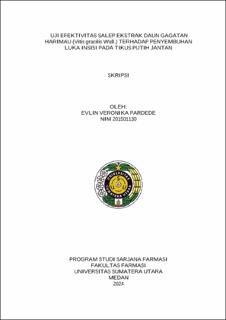Uji Efektivitas Salep Ekstrak Daun Gagatan Harimau (Vitis gracilis Wall.) terhadap Penyembuhan Luka Insisi pada Tikus Putih Jantan
Test of The Effectiveness of Gagatan Harimau (Vitis gracilis Wall.) Leaves Extract Ointment on Healing of in Incision Wounds in General White Rats

Date
2024Author
Pardede, Evlin Veronika
Advisor(s)
Surbakti, Chemayanti
Rudang, Singgar Ni
Metadata
Show full item recordAbstract
Background: A wound is a state of loss or destruction of some tissue (skin) in the body due to injury. Incisional wounds are wide but shallow wounds caused by sharp object violence. The use of gagatan harimau leaves (Vitis gracilis Wall.) in the Karo community as a wound medicine has long been used, but the basis for using plants as medicines and their efficacy is known based on hereditary experience, without scientific research.
Objective: The purpose of this study was to test the effectiveness of gagatan harimau (Vitis gracilis Wall.) leaf extract ointment in healing incision wounds in male white rats.
Method: Testing the effectiveness of extract ointment on incision wound healing uses 5 treatment groups, namely positive control, negative control, ointment with concentrations of 20%, 30% and 40%. From the wound length measurement data, the data were analyzed with ANOVA and Kruskal-Wallis tests to see whether or not there were differences between experimental groups.
Results: Concentrations of 20%, 30% and 40% have a healing effect on incision wounds in male white rats. The effectiveness of the ointment was shown by a significant difference (p < 0.05) against the negative control. Concentration 20% has the best effectiveness, where the average percent value of incision wound healing is not significantly different (p > 0.05) from the positive control.
Conclusion: That the ointment concentration of 20%, 30% and 40% has effectiveness on incision wound healing. Concentration 20% has the best effectiveness, where the results of the calculation of the average percentage of wound healing are not significantly different from the positive control.
Collections
- Undergraduate Theses [1834]
